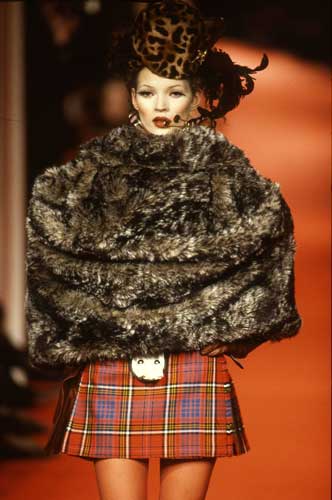By Anna Wright and Emily Ardizzone

Vivienne Westwood Autumn/Winter 1993/94, photograph by Niall McInerney, Bloomsbury Fashion Photography Archive
Fashion weeks showcase the latest trends, which often blend dazzling technical innovation with traditional craftsmanship, and from a design point of view present a heady mix of the classic and surprising, of newness and renewal. The first Fashion Week of 2013 has been no exception, with surprises including John Galliano’s controversial return to the fashion world working in collaboration with Oscar de la Renta — which may suggest the beginnings of the designer’s own reinvention — watch this space!
The fascinating new collections currently on show reveal the often cyclical nature of fashion, drawing on classic designs and reinventing them for a new age. Burberry’s new metallic/fluorescent take on the traditional trench coat, for example, is the perfect fusion of traditional design with a modern twist.
Moschino’s use of tartan for their 2013 A/W collection is a particularly interesting example of this, drawing on traditional Scottish heritage fabric and design. Tartan has featured throughout many designer collections over the years, and is favoured by designers such as Vivienne Westwood, whose A/W collection shown at the fashion week of Feb 1993 included tartan garments modelled by Naomi Campbell and Kate Moss (pictured).
Whether taking inspiration from the past or present, fashion weeks always bring with them a buzz of excitement. If you are keen to read more about the history of fashion weeks, read an exclusive free article from Berg Fashion Library.
Informed by prestigious academic and library advisors, and anchored by the 10-volume Encyclopedia of World Dress and Fashion, the Berg Fashion Library is the first online resource to provide access to interdisciplinary and integrated text, image, and journal content on world dress and fashion. The Berg Fashion Library offers users cross-searchable access to an expanding range of essential resources in this discipline of growing importance and relevance and will be of use to anyone working in, researching, or studying fashion, anthropology, art history, history, museum studies, and cultural studies.
Subscribe to the OUPblog via email or RSS.
Subscribe to only Art and Architecture articles on the OUPblog via email or RSS.
The post A history of Fashion Week appeared first on OUPblog.

By Justyna Zajac and Michelle Rafferty
This week we went to the Berg Fashion Library launch event at the New York Public Library where the talented Ada Calhoun spoke about using Berg for her own fashion research. She co-authored Gunn’s Golden Rules: Life’s Little Lessons for Making it Work and is now working on another book with Tim Gunn, the forthcoming Tim Gunn’s Fashion Bible.
We had the chance to speak with Ada after the event about 90s fashion (her blog 90swoman is sweet) and shopping for costumes with her son:
Click here to view the embedded video.
Fun Facts We Learned about Fashion from Ada & Berg:
-Sometimes the past is better left in the past – that means you ill-fitting flannel shirt.
-The most common designer Project Runway applicants list as their inspiration is Chanel – spelled Channel.
-Ballet inspired fashion is coming soon – thank you Black Swan!
-The “f-word” also refers to fashion – courtesy Valerie Steele.
-When discussing your fashion thesis with academics, make sure they know you’re not talking about a fascism thesis (again courtesy Valerie Steele).


By: Jerry Beck,
on 9/15/2010
Blog:
Cartoon Brew
(
Login to Add to MyJacketFlap)
JacketFlap tags:
CGI,
iPad,
Berg,
Add a tag
Interface designers BERG used iPads to create an ingenious experiment that combines the device with photography and animation. After building CG models of a typeface, they rendered a sequence of cross sections of the letters—think David Daniels’ strata-cut animation technique adapted to CG. Now, the strata-cut technique wouldn’t typically work in CG imagery because the calculated perfection of the computer disallows spontaneity, but BERG solved that by playing back the sequences on the iPad while dragging it through space to extrude the animation into physical space. Each frame of the film, which is subject to the effects of natural human movement, is a long photographic exposure of three to six seconds. There’s more information about its making on BERG’s blog and behind-the-scenes photos are posted on Flickr.
More than anything, this experiment by BERG is a fine example of environmental animation that breaks the confines of animation’s traditionally flat and square image frame. It points to a day that is not too far off when animation will play a vital role in the real world. Imagine being in an office lobby, and depending on where you’re standing in the lobby, you’d see a different kind of animation superimposed over the physical space to guide you around. Animation need not be restricted to a passive filmic experience, and interacting with animation in our everday lives is within reach as BERG has so cleverly hinted at in this piece.
(Thanks, Dave Follett)



